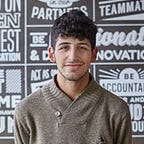Looking for your first UX Job? Let’s get it.
UX/UI is a complex field. It’s quite normal not to know where to start. In addition, it’s very common to see portfolios with many awesome projects on them, which can overwhelm us when we look for examples of how to get started.
Believe me, we all been there. The idea of these words is to help you find your first UX job or, at least get some interviews.
I am currently part of the recruiting process at Making Sense. We interview many junior designers. In this article, we can talk a little bit about what we look for in those designers, what makes them reach an interview. Let’s start:
First of all
So, you’re trying to get a job as a UXer. My question here would be: are you thinking like a UXer? As you know, a UX designer focuses all (or most of) her/his efforts on the user.
👉 You have a product: you.
👉 You have users: your future employers or, let’s say, your future employers’ recruiters.
The first thing to know is about the recruiters’ needs. Most companies have recruiters, people in the HR (Human Resources) team whose task is to search and find people like you, potential employees. When they find one, or her/his CV arrives, they send us (the design team) their portfolio to evaluate the profile and see if it is worth a technical interview.
As the saying goes, time is money. The design team cannot interview all the profiles that arrive at the company, so you must make a good impression before an interview. That way you’ll earn it.
Evaluating a profile
Of course, the evaluation varies from profile to profile, but mainly from seniority to seniority. For instance, when evaluating a senior profile, they look for things at that level (leadership, management, etc.). When we evaluate a junior profile (you) we look for potential. We know you have no experience. We know these are your first steps in the field. Trust me, we know.
That said, what do we look for in a junior profile? Or, let’s talk about me: what do I look for?
🧠 Process
First of all, I need to know how the designer thinks. We appreciate this in an interview, where we present some common problems and questions and let the designer solve the issues ao vivo. However, another tool that you have to show this is the case studies. We are looking for projects where we can see your problem-solving process. We don’t look for beautiful results, we analyze things like:
- Definition of the problem.
- Research.
- Analysis.
- Wireframing.
- Testing.
- Etc.
Not all are necessary or exclusive. With those, we see how your brain works to solve a situation. I call it the “way of thinking”. You get the idea.
For more concrete examples, think about the case studies you see on Behance. Their focus is the definition of the problem, the research, the idea. Of course, you’ll see visual stuff in them, but the goal of a case study is to explain how the designer got to the UI.
You need to have one of this type.
🎨 Visual
Visual design. Obvious. This is the first filter, mainly because it’s the first thing we see. As before, we look for potential here. We’re not looking for the best visual design that we’ll see in our lives (although it might surprise us), but something that lets us know you can handle different visual situations, such as:
- Mobile patterns.
- Visual aids.
- Accessibility (well, this is a difficult one)
- Trends.
- A great etcetera.
To speak in platforms language, Dribbble… BUT. Dribbble is nice, but we all know that Dribbble shots are just that, shots. 99% of the time we won’t see anything like those on the street, and that’s fine. Dribbble is the home of visual design, you won’t see UX there.
Try some UI challenges, redesign a website you like, post your shots somewhere. Be visual.
🎯 To sum up
I wrote a lot, and you had to read a lot. Sorry for that. A short summary 👇
You need two things:
🧠 Show how you think: You have some projects you did for a UX course. You analyzed heuristics, for example. That perfectly shows how you think and how your mind works. Upload that to a platform like Behance, or write an article about it. A Behance with only one project is fine, don’t be afraid. Platforms that can help with this:
- Behance
- Medium, if you prefer to write an article (please be visual, not too many text blocks)
- Notion
- What works for you
🎨 Show your visual skills: Prepare some visual shots and upload them to any platform. Platforms for this:
- Dribbble
- Behance
- Instagram, why not
- Again, whatever works for you.
🦸 Of course, a nice CV.
These are some things that would help you be considered for an interview. You may have some or most of them, you just need to organize them. If not, hopefully, this will give you an idea of where to start :)
